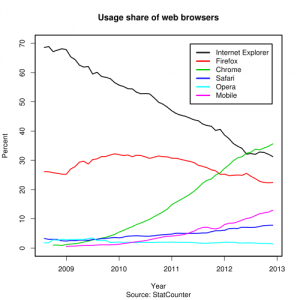This is a basic tutorial of the first use of Google Blueprint as a CSS layout.
Download Blueprint CSS
Download the main library att Google Code, at the time of this writing that is the file “Blueprint 0.7.1.zip”.
http://code.google.com/p/blueprintcss/downloads/list
There are three folders in the ZIP-file, first you have the “blueprint” folder which contains the ready to use CSS-files (ie.css, print.css and screen.css). While there are more files in that folder we will only concern ourselves with those in directly in the “blueprint” folder and not subfolders.
I will not go into detail about the two other folders, for your information the “lib” folder contains YAML source for the project and the last folder “tests” contains sample pages you can play around with if you’d like.
Fast reference PDF
There is a nice “cheat page” you can print out from a PDF, this is optional though but I found it very helpfull at least while learning the new classes.
Link the CSS-files
All you need to do is copy the three CSS-files in the “blueprint” folder into a directory of your choice in the main HTTP directory. I assume you put them in a subdirectory simply called “blueprint”. Next you need to link them in the HTML-files where you wish to use them, add the following code:
<link rel=”stylesheet” href=”blueprint/screen.css” type=”text/css” media=”screen, projection”>
<link rel=”stylesheet” href=”blueprint/print.css” type=”text/css” media=”print”>
<!–[if IE]><link rel=”stylesheet” href=”blueprint/ie.css” type=”text/css” media=”screen, projection”><![endif]–>
The first CSS defines how to display the page on normal monitors and projectors. The second file is for printing and the last file, surrounded with an IF condition to only be used by Internet Explorer, is specific instructions for the naughty web browsers that do not follow the standards.
Make a HTML file that uses the Blueprint
I assume you know HTML and CSS so I skip the basics and move straight to the new classes that blueprint offers. Simply put you need an outer DIV of the class “container” that will be the parent object of all others. Inside of this you can decleare HTML code as normal. A real simple first page could look something like this:
<div class=”container”>
<div class=”span-24 last”>
<h1>Hello World</h1>
</div>
</div>
The outer DIV is the container of all objects. The second div defines itself as a “span-24” and “last” class. Span-24 is the max width (950 pixels) and will span the entire area inside the container, last is added to signal this is the final column on this row (it’s also the only so in this case maybe a bit overkill).
Now after this it’s very easy to expand the concept, for example to make a “top headline and under menu + content” layout simply write:
<div class=”container”>
<div class=”span-24 last”>
<h1>Hello World</h1>
</div>
<div class=”span-4″>
The menu
</div>
<div class=”span-20 last”>
The content
</div>
</div>
This still doesn’t solve the more complex aspects of CSS-layout when you need everything to be “just right” but with an overall layout made this easy you can focus on the end tweaking instead of re-inventing the basic wheel everytime you need to make a new design.
Conclusion
The absolute best part about the Blueprint CSS is a “small” feature internally namned “rest.css” which is part of the “screen.css” file. This resets all browser settings to one single setting (Firefox, Internet Explorer etc all have slightly different default values for border, margins, padding etc) making cross platform development much much easier. Secondly, and the acctual main purpose, the ability to easily create new columns and layout modifications really improves start up development time of new designs. While the Blueprint CSS just have very basic settings it’s often these basic settings that screw up every new design I make since I tend to aim a little too high everytime I write a new CSS-class.
